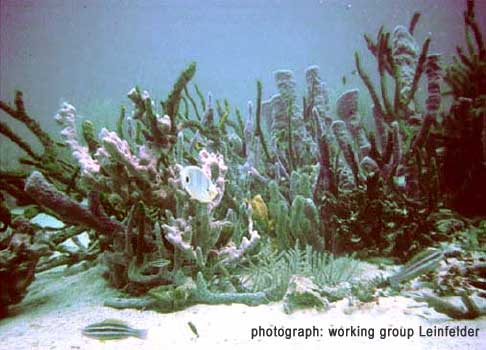
Fig.: ensemble of various soft sponges from a Caribbean reef.
These sponges are very interesting for the pharmaceutic industry.
1.3.1.6 Importance of reefs for the human society (cont...)
d) Pharmaceutical Resources
The available space in the reef is so restricted that competition for space is one of the major challenges for reef organims. So it is understandable that many, especially those sessile organisms which cannot hide or run away, invented various ways of protection and defense. Stone corals are considerably well protected by their calcareous skeletons, but soft bodied benthic organisms such as soft sponges and soft corals frequently protect or defend themselves by developing obnoxious or even poisonour metabolic substances. The high density of organisms in the reef also facilitates bacterial infections, so many natural antibiotics are also produced in the reefs. All these defensive or protective metabolic products (plus others) are highly interesting for developing new medicines. This is just another aspect where reefs and rain forests share many similarities.

Fig.: ensemble of various soft sponges from a Caribbean reef.
These sponges are very interesting for the pharmaceutic industry.
Here are a few examples:
Prostaglandin is a superb, multipurpose remedy matter which in particular activates smooth muscle fibres (# Übersetzung von glatte Muskeln nachsehen##). It also is used as a medine for stomach ulsters, asthma, circulatory defects as well as for facilitating births. Phantastic stuff! However, it used to be produceable only in microgram proportions, from bladders of sheep and used to be at least 100 times more costly than gold. Since some time, the material can be extracted nearly in gram-quantities from horn corals such as Plexaura (these are concentrations 10 million times higher than in sheep).
Antibiotics: as said above, a lot of natural antibiotics still await discovery in reefs. In the reef they help against bacterial reef deseases and as a defence against biochemical aggression in reefs.
Ara C is a metabolic antiviral product of sponges and is promising for the battle against human cancer and aids, but also helps against herpes viruses. Most important, it could be reproduced with genetic technology methods in the lab, just copying the natural example. This is how pharmaceutic products should be used from the reef: detected in the reef, but rebuilt and produced in the lab or in special marine farms. Extensive collection of reef organisms would otherwise damage reefs at a ver high speed, and thus deprive us from this so very important resource.
Bone substitutes: Calcareous skeletons of scleractian corals have been successfully used as substitutes for human bones. The human body seems to be more tolerant to this material than to many other substitutes.
The economic value of this medical resource is probable not even estimable. This alone would be reason enough to carefully protect all our reefs.
Further Reading: Mebs, D. (1988): Gifte im Riff.- Wissenschaftl. Verlags-Ges. Stuttgart.
This page is part of www.palaeo.de/edu/reefcourse,
last changes